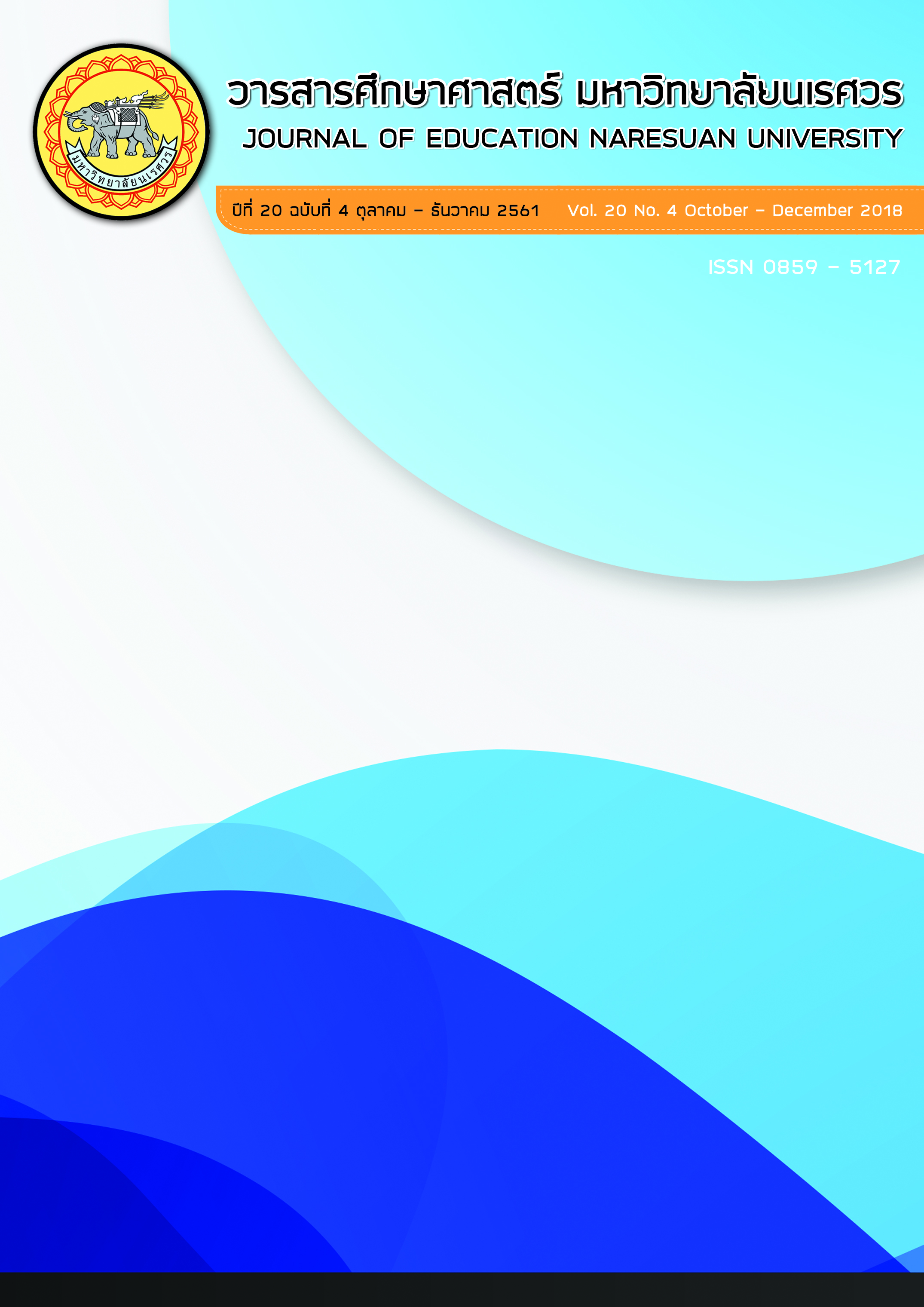การออกแบบรูปแบบการเรียนการสอนด้วยกระบวนการเรียนรู้แบบ MIAP บนเทคโนโลยีการประมวลผลแบบคลาวด์ของนักศึกษาระดับปริญญาตรี เพื่อส่งเสริมทักษะการเรียนรู้ในศตวรรษที่ 21; INSTRUCTIONAL MODEL OF MIAP ON CLOUD COMPUTING TECHNOLOGY OF THE UNDERGRADUATE STUDENTS IN ORDER TO PROMOTE 21st CENTURY LEARNING SKILL
Main Article Content
Abstract
การวิจัยครั้งนี้มีวัตถุประสงค์เพื่อ 1) วิเคราะห์และสังเคราะห์กรอบของรูปแบบการเรียนการสอนด้วยกระบวนการเรียนรู้แบบ MIAP บนเทคโนโลยีการประมวลผลแบบคลาวด์ของนักศึกษาระดับปริญญาตรี เพื่อส่งเสริมทักษะการเรียนรู้ในศตวรรษที่ 21 2) ออกแบบรูปแบบการเรียนการสอน และ 3) ประเมินรูปแบบการเรียนการสอน โดยมีกลุ่มตัวอย่างเป็นผู้เชี่ยวชาญด้านเทคนิคและวิธีการสอน และด้านเทคโนโลยีสารสนเทศและการสื่อสาร จำนวน 5 ท่าน ใช้การเลือกแบบเจาะจง เครื่องมือที่ใช้ในการวิจัย คือ 1) รูปแบบการเรียนการสอนด้วยกระบวนการเรียนรู้แบบ MIAP บนเทคโนโลยีการประมวลผลแบบคลาวด์ของนักศึกษาระดับปริญญาตรี เพื่อส่งเสริมทักษะการเรียนรู้ในศตวรรษที่ 21 2) แบบประเมินความคิดเห็นเกี่ยวกับผลการวิเคราะห์และสังเคราะห์ และ 3) แบบประเมินความเหมาะสมของผลการวิเคราะห์รูปแบบ วิเคราะห์ข้อมูลโดยใช้ค่าเฉลี่ยเลขคณิต และส่วนเบี่ยงเบนมาตรฐาน ผลการวิจัย พบว่า 1) รูปแบบการเรียนการสอน ประกอบด้วย 1.1) กระบวนการเรียนรู้แบบ MIAP 1.2) ทักษะการเรียนรู้ในศตวรรษที่ 21 1.3) ผู้ใช้งานรูปแบบ ประกอบด้วย อาจารย์ และนักศึกษา และ 1.4) เทคโนโลยีการประมวลผลแบบคลาวด์ 2) ความคิดเห็นของการวิเคราะห์และสังเคราะห์กรอบของรูปแบบการเรียนการสอน ประกอบด้วย การวิเคราะห์ปัจจัยนำเข้า การวิเคราะห์กระบวนการจัดการเรียนการสอน และการวิเคราะห์ความต้องการจำเป็น ภาพรวมอยู่ในระดับมากที่สุด ( = 4.87, S.D. = 0.35) และ 3) ความเหมาะสมของรูปแบบการเรียนการสอน ประกอบด้วย ความเหมาะสมของการออกแบบรูปแบบ และความเหมาะสมในการนำรูปแบบไปใช้งานจริง ภาพรวมอยู่ในระดับมากที่สุด (
= 4.90, S.D. = 0.32)
INSTRUCTIONAL MODEL OF MIAP ON CLOUD COMPUTING TECHNOLOGY OF THE UNDERGRADUATE STUDENTS IN ORDER TO PROMOTE 21st CENTURY LEARNING SKILLS
The purposes of this study are: 1) to analyze and synthesize the framework of the instructional model of MIAP on cloud computing technology of the undergraduate students in order to promote 21st Century learning skills; 2) to design the instructional model; and 3) to evaluate the instructional model. The sample of this study are five experts in techniques and teaching methods as well as in information technology and communication by using the purposive sampling design. The research instruments are 1) the instructional model of MIAP learning process on cloud computing of the undergrad students in order to promote 21st Century learning skills; 2) the opinion evaluation forms of the research model regarding the results of the analysis and synthesis of the framework mentioned; and 3) the appropriateness evaluation form regarding the appropriation of the result of the data analysis of the model by using mean, and standard deviation. The results of the study show that 1) the instructional model consisting of 1.1) MIAP process of learning 1.2) 21st Century learning skills 1.3) the users of the model containing instructors and students, and 1.4) cloud computing technology; 2) the comments through the analysis and synthesis of the framework of instructional model consisting of input analysis, MIAP process analysis, and needs analysis with the highest scale ( = 4.87, S.D. = 0.35) in overall; and 3) the appropriation of the instructional model containing the appropriation of model design and the appropriation of the implementation in real situation with the highest scale (
= 4.87, S.D. = 0.35) in overall.
Article Details
The owner of the article does not copy or violate any of its copyright. If any copyright infringement occurs or prosecution, in any case, the Editorial Board is not involved in all the rights to the owner of the article to be performed.
References
Buaphai, T., et al. (2015). A model of ICT competency training for teachers in basic information technology and communications. Course primary level in the Basic Core Curriculum of the Basic Education B.E. 2551 under the Office of the Basic Education Commission. Technical Education Journal, 6(1), 68-77. (in Thai)
Kamolchaipisit, K. (2012). Online learning under cloud computing. Advanced Science Journal, 12(2), 8-18. (in Thai)
Kankaew, V., & Jeerungsuwan, N. (2015). The design of collaborative learning pattern through
the use of cloud technology for supporting the college students' creative thinking. Technical Education Journal, 6(1), 197-204. (in Thai)
Meesuwan, W. (2014). Cloud computing for education. Journal of Education Naresuan University, 16(1), 149-157. (in Thai)
Ministry of Education. (2008). Course core basic education act 2551. Bangkok: Agricultural Cooperative Federation of Thailand Printing. (in Thai)
Office of the Higher Education Commission. (2015). Quality Assurance in Education B.E.2557 Manual. Bangkok: Phappim Publication. (in Thai)
Peanprasert, N., & Jeerangsuwan, N. (2016). Smart classroom: New room to challenges in
21st Century. Journal of Technical Education Development, 28(97), 21-24. (in Thai)
Phonak, D., & Tipsuwan, W. (2012). The Study of Learning Outcome for MIAP Learning Model Integration with Social Media for the Student Teaching under Teaching Techniques Consulting of Teacher Supervision. Kasetsart University Annual Conference, 50(2555), 118-126. (in Thai)
Pinrattananont, R., (2014). The factors towards educational achievement of graduates of information system field in Rajamangala University of Technology Isan.
Suranaree J. Soc. Sci, 8(1), 23-35. (in Thai)
Pongsawat, P., & Jeerungsuwan, N. (2015). The instruction design flipped classroom model by using WebQuest activities to develop learning skills in the 21st century for students in higher education. Technical Education Journal, 6(1), 151-158. (in Thai)
Promjun, S. (2010). Tactical teaching techniques (5th ed.). Bangkok: KMUTNB. (in Thai)
Sirisukpaiboon, S. (2011). Techniques and methods of teaching profession (15th ed.). Bangkok: KMUTNB. (in Thai)
Songsangyot, P., & Jeerangsuwan, N. (2015). Cloud computing with 21st century skill. Journal of Technical Education Development, 27(95), 9-15. (in Thai)
Srisakonsub, P., & Jeerungsuwan, N. (2015). The design of collaborative learning using cloud computing technology in order to improve the 21st century learning skills for college students. Technical Education Journal, 6(2), 12-18. (in Thai)
Sungpoom, V. (2011). Instructional Model based on Connectivism Theory. Journal of Vocational and Technical Education, 1(2), 50-56. (in Thai)
Wangjeen, A. (2014). Causal factors that undergrate student in Bangkok probation conditions. APHEIT Journal, 20(2), 136-147. (in Thai)

